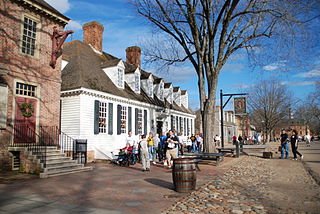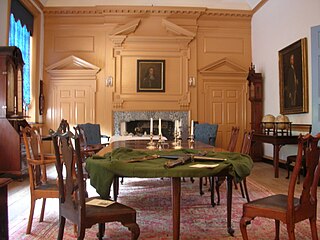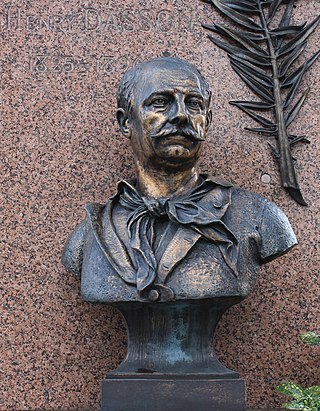
Martinsville is an independent city in the Commonwealth of Virginia in the United States. As of the 2020 census, the population was 13,485. A community of both Southside and Southwest Virginia, it is the county seat of Henry County, although the two are separate jurisdictions. The Bureau of Economic Analysis combines the city of Martinsville with Henry County for statistical purposes.

Danville is an independent city in the Commonwealth of Virginia in the United States. The city is located in the Southside Virginia region and on the fall line of the Dan River. It was a center of tobacco production and was an area of Confederate activity during the American Civil War, due to its strategic location on the Richmond and Danville Railroad. In April 1865 it briefly served as the final capital of the Confederate States before its surrender later that year.

Colonial Williamsburg is a living-history museum and private foundation presenting a part of the historic district in the city of Williamsburg, Virginia. Its 301-acre (122 ha) historic area includes several hundred restored or recreated buildings from the 18th century, when the city was the capital of the Colony of Virginia; 17th-century, 19th-century, and Colonial Revival structures; and more recent reconstructions. The historic area includes three main thoroughfares and their connecting side streets that attempt to suggest the atmosphere and the circumstances of 18th-century Americans. Costumed employees work and dress as people did in the era, sometimes using colonial grammar and diction.

The Middle Peninsula is the second of three large peninsulas on the western shore of Chesapeake Bay in Virginia, in the United States. As of the 2020 census, the Middle Peninsula was home to 92,886 people. It lies between the Northern Neck and the Virginia Peninsula. This peninsula is bounded by the Rappahannock River on the north and the York River on the south, with the Chesapeake Bay to the east. It encompasses six Virginia counties: Essex, Gloucester, King and Queen, King William, Mathews, and Middlesex. Developed for tobacco plantations in the colonial era, in the 21st century the Middle Peninsula is known for its quiet rural life, vegetable truck-farming, and fishing industry.
George Hepplewhite was a cabinetmaker. He is regarded as having been one of the "big three" English furniture makers of the 18th century, along with Thomas Sheraton and Thomas Chippendale. There are no pieces of furniture made by Hepplewhite or his firm known to exist but he gave his name to a distinctive style of light, elegant furniture that was fashionable between about 1775 and 1800 and reproductions of his designs continued through the following centuries. One characteristic that is seen in many of his designs is a shield-shaped chair back, where an expansive shield appeared in place of a narrower splat design.

Southside, or Southside Virginia, has traditionally referred to the portion of the state south of the James River, the geographic feature from which the term derives its name. This was the first area to be developed in the colonial period.

Thomas Bahnson Stanley was an American politician, furniture manufacturer and Holstein cattle breeder. A Democrat and member of the Byrd Organization, Stanley served in a number of different political offices in Virginia, including as the 47th speaker of the Virginia House of Delegates and as the Commonwealth's 57th governor. He became known for his support of the Massive Resistance strategy to prevent school desegregation mandated by the United States Supreme Court's decisions in Brown v. Board of Education, and Virginia's attempt to circumvent those decisions was known as the Stanley Plan.

Ready-to-assemble furniture (RTA), also known as knock-down furniture (KD), flat pack furniture, or kit furniture, is a form of furniture that requires customer assembly. The separate components are packed for sale in cartons which also contain assembly instructions and sometimes hardware. The furniture is generally simple to assemble with basic tools such as screwdrivers, which are also sometimes included. Ready-to-assemble furniture is popular with consumers who wish to save money by assembling the product themselves.
La-Z-Boy Inc. is an American furniture manufacturer based in Monroe, Michigan, United States, that makes home furniture, including upholstered recliners, sofas, stationary chairs, lift chairs and sleeper sofas. The company employs more than 11,000 people.

Depression glass is glassware made in the period 1929–1939, often clear or colored translucent machine-made glassware that was distributed free, or at low cost, in the United States and Canada around the time of the Great Depression. Depression glass is so called because collectors generally associate mass-produced glassware in pink, yellow, crystal, green, and blue with the Great Depression in America.

Ferry Farm, also known as the George Washington Boyhood Home Site or the Ferry Farm Site, is the farm and home where George Washington spent much of his childhood. The site is located in Stafford County, Virginia, along the northern bank of the Rappahannock River, across from the city of Fredericksburg. In July 2008, archaeologists announced that they had found remains of the boyhood home, which had suffered a fire during 1740, including artifacts such as pieces of a cream-colored tea set probably belonging to George's mother, Mary Ball Washington. In 2015, the George Washington Foundation began constructing a replica of Washington's boyhood home on the site of the original building. The replica house was completed in 2018 and is open to the public.

Williamsburg Pottery Factory is a large, multi-structure retail outlet store located in Lightfoot, Virginia, about 6 miles (9.7 km) west of Williamsburg. It was founded in 1938 by James E. Maloney as a small pottery workshop. The Williamsburg Pottery Factory now markets itself as one of Virginia's largest tourist attractions. Referred to by the locals as "the Pottery", the 200-acre (0.81 km2) attraction offers a selection of locally handmade articles, as well as imports from 20 countries. Williamsburg Pottery was once famous for its "bare bones" appearance; however, it underwent a multimillion-dollar redevelopment that reshaped its look in the spring of 2012.

A lighthouse clock is a type of mantel clock manufactured in the U. S. from 1818 through 1830s by the American clockmaker Simon Willard, having the dial and works exposed beneath a glass dome on a tapered, cylindrical body.
Biggs Furniture, based in Richmond, Virginia, United States, was once a leading U.S. manufacturer of colonial reproduction furniture. The company flourished in the 20th century, alongside reproductions by Colonial Williamsburg by the Kittinger Company, and other mass market reproduction brands like Ethan Allen and Pennsylvania House. In 1975, the company was purchased by the Kittinger Company.
The Kittinger Company is an American maker of traditional colonial reproduction furniture that was founded in 1866. Today Kittinger is known for the high-quality furniture it produces that is featured prominently in the White House.

A cabinet is a case or cupboard with shelves and/or drawers for storing or displaying items. Some cabinets are stand alone while others are built in to a wall or are attached to it like a medicine cabinet. Cabinets are typically made of wood, coated steel, or synthetic materials. Commercial grade cabinets usually have a melamine-particleboard substrate and are covered in a high pressure decorative laminate, commonly referred to as Wilsonart or Formica.

William Savery was an 18th-century American cabinetmaker noted for his furniture in the Queen Anne and Philadelphia Chippendale styles.

Henry Dasson (1825–1896) was a renowned nineteenth century Parisian maker of gilt-bronze mounted furniture. Unlike other cabinetmakers of the time Dasson began his career as a bronze sculptor, and consequently one characteristic of his work is the quality of his bronze and more precisely of the chiselling.
John David Bassett, Sr. was a noted American industrialist who formed the Bassett Furniture Company in 1902. During the late 1960s, the Bassett Furniture Industries, Inc., was the largest manufacturer of wooden furniture in the world, with sales of over $118 million in 1968.
Johannes Spitler was an American painter of furniture.















